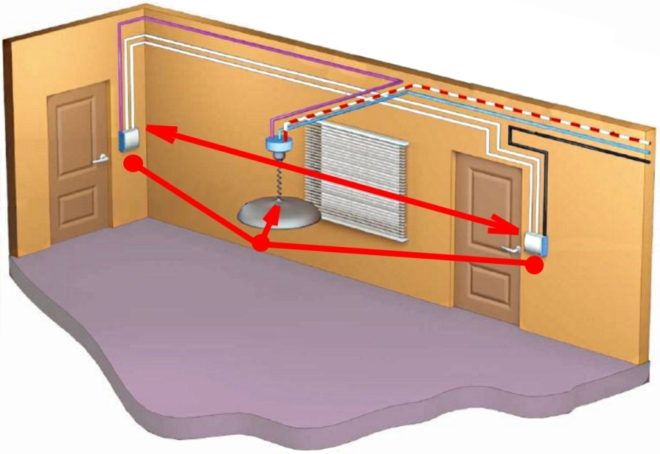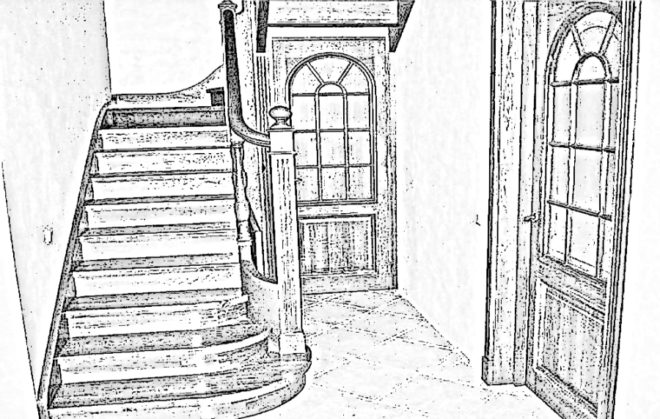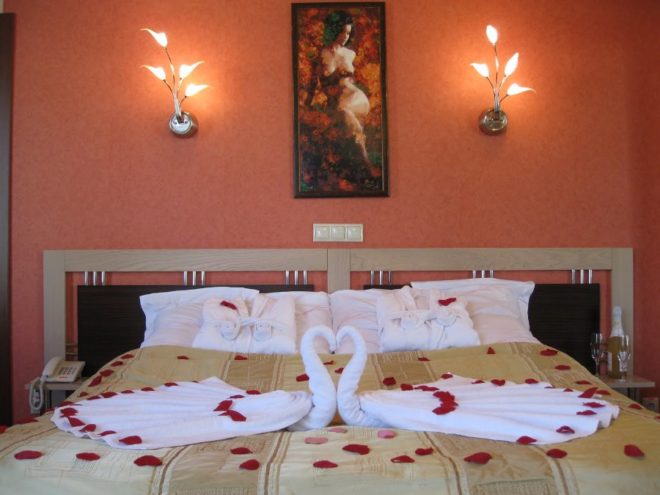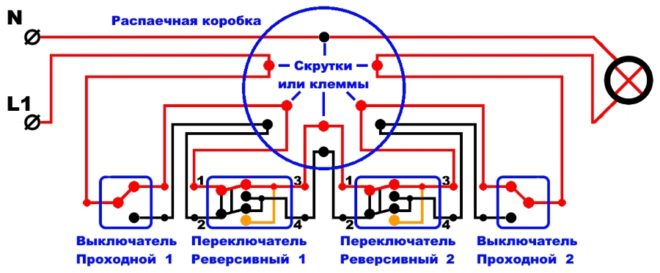Checkpoint switch - what is it, the principle of operation and varieties

If for some reason there is a need to turn on / off lighting from different places in the corridor or room, then the best solution would be a checkpoint switch: what it is, how it works, possible connection schemes and applications - all this must be understood in order to use it the most efficient, and the least expensive connection.
Content
What is a pass-through switch and how does it work
It would be more correct to call this device a switch - it is a switch for users rather out of habit, since it is used to turn on and off the lighting. If you call it correctly, then it is much easier to understand how it differs from standard switches - this name most fully reflects the essence of its effect on a working electrical circuit.
Like a standard switch, the passage has only two positions, but the fundamental difference is that in a conventional device it is strictly defined, for example, upward is on, and downward is off, while in the throughput these sides are constantly changing.
The principle of operation of the pass-through switch becomes most understandable when comparing the electrical circuits - between it and the standard device, which is shown in the figure:

If the normal in the open state simply breaks the circuit, then in the case of the pass-through, everything depends on the position of two switches at once:

It is clear from the diagram that each of the switches must have three terminals - one for the phase that goes from the power source and two for the "control" wires. When either of the two switches changes position, the circuit either closes or opens, depending on the state in which it was previously.
Additionally, one more difference between a switch and a switch can be formulated - the latter can always be connected as a simple switch, but the opposite will not work.
Where is the pass-through switch used?
Most ordinary people are not aware that, in addition to the usual, there is also a checkpoint switch - they usually find out what it is either in advance from electricians, if a competent specialist makes the wiring, or when over time you have to start actively interested in how you can turn on one lamp from different places.
The need to use a walk-through switch most often arises in large rooms, long straight and curved corridors, as well as on staircases and corridors.
The advantage of using them is the ability to turn on and off lamps and other electrical appliances not only from two, but from an unlimited number of places - it all depends on the number of switches. An example of a case when it is necessary to apply such a solution would be a staircase to the second or third floor of a house - usually they require additional lighting, especially when located on a load-bearing wall.

It is clear that when there is only one switch, then turning on the light and going upstairs, you will not be able to turn it off. Alternatively, you can install two light sources, but you have to run up and down the stairs - turn on the light at the bottom, go upstairs, light the top one, go downstairs, turn off the bottom one and go upstairs again.
Motion sensors can also be a way out, but they will also have to be installed on each floor, and the cost of such devices is higher than switches. It should also be borne in mind that they do not always work correctly - sometimes in order for the light to light up, you will not only have to walk up the stairs, but also step left or right. Still, such a solution is not suitable for those who are accustomed to manually turning on and off the light when it is needed by him, and not by the sensor.

Varieties of pass-through switches and symbols on the diagrams
Depending on how and where you plan to use such switches, their respective varieties will be applied:
For installation in the thickness of the wall and on its surface - in the second case, such switches are most often used for open wiring in wooden houses.
The wires to the circuit breaker terminals can be fastened with bolts or spring clips. The second option is considered more preferable, since it does not weaken the connection over time.
You can turn on several lamps from one place - for this they make double, triple, etc. switch models.
If there is a need to turn on lighting from three or more points, then cross (reversing) switches must be additionally purchased for two pass-throughs - according to the number of places from which the lighting will have to be turned on.
By the type of control they do not differ from the usual ones - they can be keyboard, touchscreen or with a remote control.
All types of pass-through switches in the diagrams are drawn with the same schematic designation - in fact, the same as for standard ones, but deployed in both directions.

Connecting the pass-through switch
Since more wires are used to operate the circuit with a pass-through switch, the connection in the junction box will look more complicated - additional elements will appear in it. Initially, a phase and zero come to the box from the power source. The zero wire through the connection goes directly to the lamp, and the phase wire goes to the first switch. Further in the switch, it is divided into two lines and both of them return to the box, where they go through the connection to the second switch, after which again one wire enters the junction box and through the last connection goes to the lamp.

It would be possible to save money on the wire by running the “control” branches directly from one switch to another, but a competent electrician will never do this for a number of reasons:
Connection through the box is the most correct in terms of electrical circuits.
In the event of a breakdown, another electrician will be able to ring, determine the malfunction and repair the wiring without additional searches.
This arrangement simplifies the installation of the third, fourth, etc. switch, if necessary.
As a result, a well-made connection will be made only through the junction box.
Scheme when connecting three or more switches
From the above diagram, it is clear that pass-through switches can only be used in pairs - a third similar device cannot be connected in the same way. This problem is solved by using a so-called cross or reversing switch - outwardly it looks like a normal one, but unlike it, the pass-through switch has not two or three, but four terminals.
Its purpose is to swap the connected wires when switching. For example, if the terminals are numbered, let the input terminals be 1 and 2, and the output terminals 3 and 4, respectively.Current through one wire can be supplied to terminal 1 and passing through the switch to terminal 3, and by the second one to enter terminal 2 and output through terminal 4. After switching, the current is still supplied to terminal 1, but is already output through terminal 4, and if it goes to terminal 2, it will be output through terminal 3. You can use an unlimited number of such devices in the circuit. The principle of their work in the figure:

For clarity, the circuit is given in the on state, but it is clear from it that if you change the position of any of their pass-through or reversing switches, the circuit will open. If, for example, this is the first reversible one, then the current will flow through the circuit as follows:

The lamp will not light, since the circuit will be open on the second pass-through switch. Again, it is clear that now again it is enough to change the position of any of the switches for the circuit to close and the lamp to light up.
The general disadvantages of this connection method are the high consumption of wires and the complexity of installation. It is especially easy for an inexperienced craftsman to get confused in the wire connections in the junction box, because their number increases in proportion to the number of switches used.

Each subsequent switch adds four wires to the box and two twists between them.
The work of the pass-through and reversing switches on the video is clearly visible:
Conclusion
From the above diagrams, it is clear how the pass-through switch works and what options are there for connecting it - if you have minimal skills in working with electrical equipment, a home master can also cope with its installation. If there is no experience in working with wiring, then it is better to entrust the connection of such switches to professionals - after all, this is not the simplest scheme, even despite its apparent simplicity.




